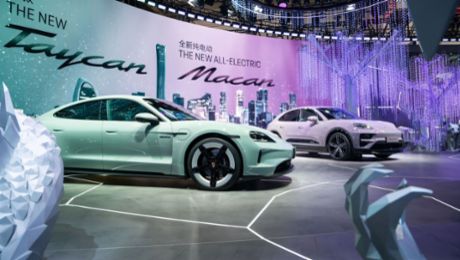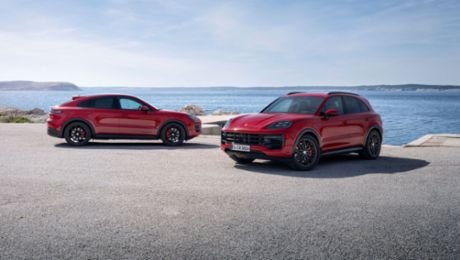Innovative glimpse into the future.
The Mission X represents the pinnacle of performance and modern luxury. At the same time, its sculpted form and muscular lines demonstrate that hypercars don’t have to look aggressive. The concept study evokes legendary racing cars from different eras of the brand’s history and propels them into the future. While Mission E showed the future of electromobility and Mission R the future of customer sport, Mission X is the vision for the next big step: experimental, exciting and extreme.
Lightweight glass dome roof and Le Mans-style doors for this futuristic concept.
A lightweight glass dome with an exoskeleton made of carbon-fibre- reinforced plastic extends over both occupants. The Le Mans-style doors are attached to the A-pillar and the roof, and they open forwards and upwards. This type of door was previously used on the legendary Porsche 917 racing car. Design elements in a carbon-weave finish are found below the beltline. These components are varnished in a satin finish and as such are slightly coloured, but their material structure remains recognisable.
Evolution of the Porsche light signature.
In the Mission X, the designers have reinterpreted the characteristic four-point graphic: the vertical base shape of the headlights has been significantly drawn down toward the road. A high-tech support structure frames the LED light modules and presents the exposed, narrow elements of the daytime driving lights and direction indicators. The sculpted rear light emerges, as if suspended in the air, from a modern support structure and extends across the entire width of the vehicle in four segments. While charging, the ‘E’ in the Porsche logo pulsates, adding a sense of mystery.
Wheels designed with great detail.
The deep-dish wheels on the concept study are only slightly covered on the front axle, while the rear wheels are fitted with almost transparent aeroblades, which are designed like turbines for better brake cooling. The double spokes are relief milled, which combines lightweight construction and stability.
Modernised Porsche crest.
One special detail is the newly modernised Porsche crest, which makes its debut on the Mission X. With its cleaner and more state-of-the-art execution, the refined crest communicates the character of Porsche. It can be found on the front panel and steering wheel of the Mission X, as well as in a monochrome design on the wheel centres.
Strong focus on the driver.
The operating and display concept is tailored to the driver, which is also reflected in the interior’s colour concept. The curved instrument cluster sits at the highest point of the steering column: other motorsport parallels include the carbon-fibre-reinforced plastic (CFRP) seat shells integrated in the monocoque and the steering wheel, which is open at the top. There are multiple cameras on board. Using the Record button on the selector lever, the driver can start recording video.
Special stopwatch module for the passenger.
Porsche Design created a bespoke stopwatch module for the Mission X, with an analogue and digital display. On the passenger side, there is a bayonet system embedded in the instrument panel, to which the stopwatch module can be attached. The clocks are designed for both circuit and rally use and can display the lap times or vital data of the driver, among other information.
Live transmission from the interior.
Spectacular film footage can be recorded from the interior: one camera mounted in the roof and two cameras in the doors next to the digital exterior mirrors record what is happening in the cabin in real time. Recording starts as soon as the driver presses the Record button (REC) on the multi-purpose controller.
High-performance, efficient electric powertrain.
Our vision, should the Mission X go into series production:
- To create the fastest road-legal vehicle on the Nürburgring Nordschleife
- A power-to-weight ratio of roughly one PS per kilogram
- To deliver more downforce than the current 911 GT3 RS
- A charging speed roughly twice as fast as that of the Taycan Turbo S.


